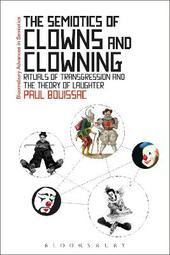
|
The Semiotics of Clowns and Clowning: Rituals of Transgression and the Theory of Laughter
Hardback
Main Details
| Title |
The Semiotics of Clowns and Clowning: Rituals of Transgression and the Theory of Laughter
|
| Authors and Contributors |
By (author) Professor Emeritus Paul Bouissac
|
| Series | Bloomsbury Advances in Semiotics |
|---|
| Physical Properties |
| Format:Hardback | | Pages:232 | | Dimensions(mm): Height 234,Width 156 |
|
| ISBN/Barcode |
9781472521736
|
| Classifications | Dewey:791.33014 |
|---|
| Audience | | Undergraduate | | Postgraduate, Research & Scholarly | |
|---|
| Illustrations |
40 illus
|
|
Publishing Details |
| Publisher |
Bloomsbury Publishing PLC
|
| Imprint |
Bloomsbury Academic
|
| Publication Date |
21 May 2015 |
| Publication Country |
United Kingdom
|
Description
During the last 300 years circus clowns have emerged as powerful cultural icons. This is the first semiotic analysis of the range of make-up and costumes through which the clowns' performing identities have been established and go on developing. It also examines what Bouissac terms 'micronarratives' - narrative meanings that clowns generate through their acts, dialogues and gestures. Putting a repertory of clown performances under the semiotic microscope leads to the conclusion that the performances are all interconnected and come from what might be termed a 'mythical matrix'. These micronarratives replicate in context-sensitive forms a master narrative whose general theme refers to the emergence of cultures and constraints that they place upon instinctual behaviour. From this vantage point, each performance can be considered as a ritual which re-enacts the primitive violence inherent in all cultures and the temporary resolutions which must be negotiated as the outcome. Why do these acts of transgression and re-integration then trigger laughter and wonder? What kind of mirror does this put up to society? In a masterful semiotic analysis, Bouissac delves into decades of research to answer these questions.
Author Biography
Paul Bouissac is Professor Emeritus at the University of Toronto (Victoria College), Canada. He is a world renowned figure in semiotics and a pioneer of circus studies. He runs the SemiotiX Bulletin [www.semioticon.com/semiotix] which has a global readership.
ReviewsOne of the major contributions of the book is that, after reading it, watching clown performances can never be the same: the author guides us through the semiotics of clowning in such detail that every move and feature of clown acts will be overloaded with meaning(s) for the readers ... [A] reader-friendly book and an invaluable ethnographic approach to an area of study that has been most neglected by (humour and other) scholars ... particularly interesting for humour researchers, especially those who investigate clown performances in or, mostly nowadays, outside circuses. * European Journal of Humour Research * An important addition to literature on clowns and laughter, and an ambitious attempt to address in transcendent terms the negotiation of meaning at the heart of clown-generated laughter ... Valuable insights into practice abound ... Bouissac's knowledge of and sensitivity to a breadth of cultural contexts allows for fascinating and relevant examinations of time-honored clown routines ... Indeed his book finds its full value in a sustained reflection from a perspective we don't usually encounter: the sign-rich soil beneath our social interaction and the precise manner of its playful overturning by the classic circus clown. * Humor * In this book, Paul Bouissac, pioneer and master of the scientific approach to circus arts, demonstrates in a complete and brilliant way, by semiotic, anthropological and cognitive approaches, how the clowning art is a multimodal and complex act of communication, which produces laughter and sense through cognitive and cultural constructions shared by artists and spectators. THE definitive reference to understand clowning! -- Philippe Goudard, Professor of Performing Arts, Universite Paul Valery Montpellier, France Bouissac brings his customary rigour and a true respect and love for the art of clowning to the task of discussing what clowns actually do and what it might mean. The full force of semiotic analysis bears generous fruit as Bouissac bases any theoretical analysis or deductions upon actual detailed descriptions of clowns in action. A hugely valuable contribution to the growing field of clown studies and an antidote to the lazy off-the-shelf popular mythologizing about clowning which passes for commentary in many quarters. -- Jon Davison, Royal Central School of Speech and Drama, University of London, UK
|